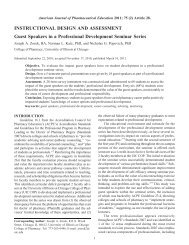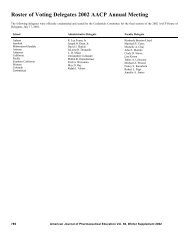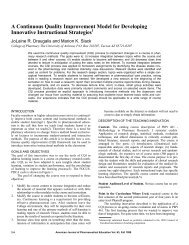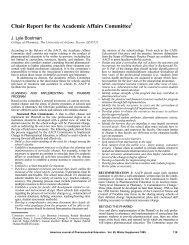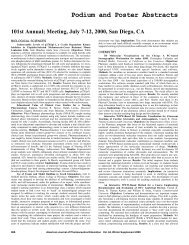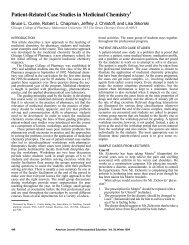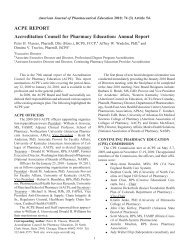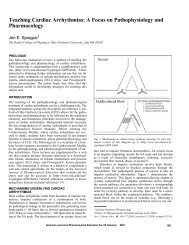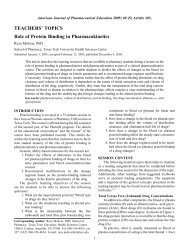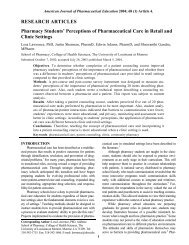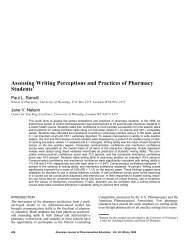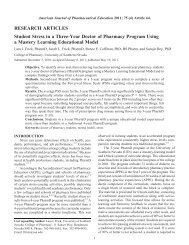RESEARCH ARTICLES Pharmacy Students' Attitudes Toward a ...
RESEARCH ARTICLES Pharmacy Students' Attitudes Toward a ...
RESEARCH ARTICLES Pharmacy Students' Attitudes Toward a ...
Create successful ePaper yourself
Turn your PDF publications into a flip-book with our unique Google optimized e-Paper software.
American Journal of Pharmaceutical Education 2009; 73 (7) Article 134.<br />
taught the course displayed enthusiasm, positive energy,<br />
and commitment to public health activities, which may<br />
have influenced student assessment of the course. Given<br />
the similar results of earlier studies focusing on students’<br />
opinions of elective and experiential courses, pharmacy<br />
students seem to see a lot of value in taking public healthrelated<br />
courses. It could also be due to the high expectations<br />
or perceptions first-year pharmacy students may<br />
have about pharmacists’ roles in the health care system.<br />
Finally, it could also be a function of the rating scale used<br />
to measure pharmacy student attitudes in this study.<br />
From an academic pharmacy perspective there are<br />
several implications from the findings of the study. <strong>Pharmacy</strong><br />
student enthusiasm about public health education is<br />
high. This provides an opportunity to not only make public<br />
health education a part of pharmacy education but also<br />
make curricular changes and interventions required to develop<br />
pharmacy student competencies and facilitate them<br />
in becoming public health care providers. Because this is<br />
the only public health course offered in their pharmacy<br />
education, students’ positive attitudes for a public health<br />
course should be maintained and support given throughout<br />
their education so that they can implement health promotions<br />
programs in their future professional practice.<br />
This could be done through several mechanisms including<br />
collaborations between schools offering public health<br />
5<br />
degrees and pharmacy schools, pharmacy schools and departments<br />
of public health, and student participation in research<br />
activities identified by the PharmD gateway to the<br />
National Institute of Health. 19 Finally, it is essential to create<br />
an environment where students realize that the burden<br />
of working together and creating common public health<br />
goals rests on the shoulders of all healthcare professionals.<br />
So far, the medical and nursing professions have taken an<br />
active lead in developing health promotion and disease<br />
management programs. This study shows that future pharmacists<br />
will be more receptive to active participation in<br />
health promotion and disease management programs.<br />
However, more work needs to be done to create public<br />
health program teams that include physicians, nurses, pharmacists,<br />
and allied healthcare professionals. Again, collaborations<br />
between medical, nursing, and pharmacy schools<br />
can serve as a forum through which pharmacy students can<br />
become an integral part of a public health care team.<br />
Since the course is relatively new, the pedagogic exercise<br />
that required developing but not implementing<br />
a public health program was designed to get students to<br />
think about the issue and their future role as pharmacists<br />
in health promotion and disease prevention. While this<br />
was the first step, teaching students how to implement<br />
their public health programs will be vital to them realizing<br />
the impact they could have on the development and



